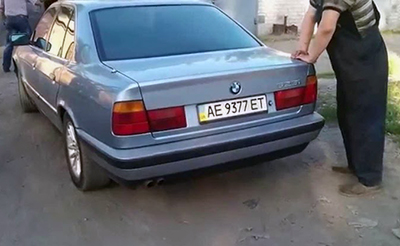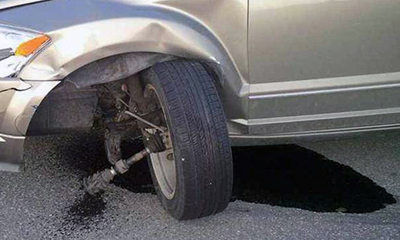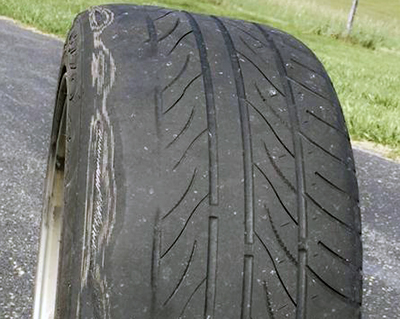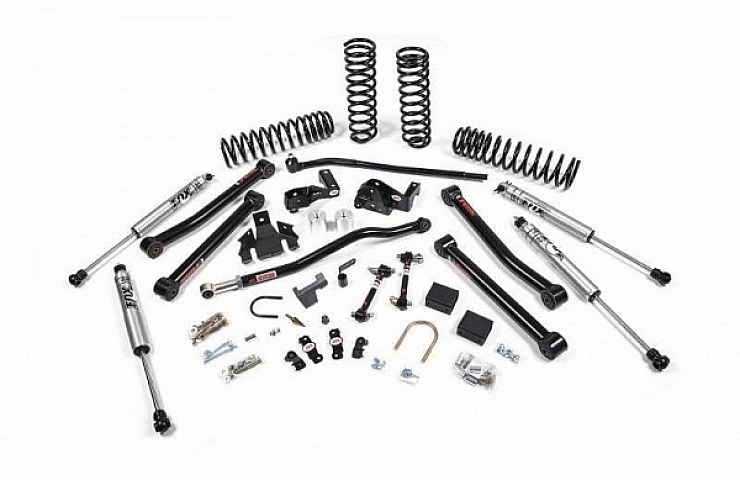Your car’s suspension system—consisting of springs, shock absorbers, tires, and other parts—manages the body’s slight bouncing motion. The type of suspension determines if you feel the road or float over the deepest pothole. Even though suspension components are designed to last many miles, the punishment of daily driving eventually wears them down, sometimes to the point of failure. What are the warning signs that your suspension is no longer doing its job? Here’s a quick list and what to do about it.

Test your shock absorbers using the so-called bounce test.
1. Your car nose-dives when stopping.
If the front end of your car dips when you come to a stop—otherwise known as a nose-dive—it can indicate that your shock absorbers need to be replaced. To know for sure, give your care a bounce test. With the car parked on level ground, push down and release a corner of the vehicle. The car should bounce back up and settle in one bounce. If the car bounces more than once before it settles, you should consider a new set of shock absorbers. Shocks should be replaced as a set, never individually.
2. Your car is lower on one corner than the rest of the car.
If you have a droopy corner, first make sure that your tires are correctly and equally inflated. If that doesn’t make a difference, it could mean that a suspension component—a control arm, bushing, spring, or strut—is failing. If so, the car is probably not safe to drive. Have it thoroughly inspected by a professional mechanic.

If ignored, a failing suspension can eventually lead to a roadway accident.
3. The car drifts on the road or pulls to one side.
A drifting ride can be a sign that a brake pad is dragging on its rotor or could indicate that suspension parts, like ball joints or control arms, are worn out. An easy way to check is to park the car on a level surface—and then push and pull on each of the front tires. Check to see if the wheel and tire move separately from the rest of the car. If so, you might have a problem with one of the suspension parts. Again, this could have serious safety implications. Have your car examined as soon as possible to avoid breaking down, or an accident, on the road.
4. Your car rides exceptionally rough or makes rattling noises when traveling on a bumpy road.
Is your vehicle suddenly riding much rougher than it used to? Are you hearing unusual sounds coming from near the front or rear wheels? Is the steering wheel starting to jerk and vibrate? These are all signs that you hit a pothole, possibly damaging your tire or rim. Take a close look at all four tires and wheels for potential damage—and consider a repair or replacement.

Uneven tire wear could indicate a suspension problem.
5. Your tires are unevenly worn.
Vehicle suspensions have adjustments to make sure the car moves down the road in a straight line. If the so-called suspension alignment is out of specification, it can cause the tires to rapidly and unevenly wear—adversely impacting your vehicle’s handling and braking. If your tires aren’t wearing evenly, consider getting a suspension alignment. Uneven tire wear can also be a sign of worn-out suspension components.
Check your cars owners manual for how often you should inspect your suspension for wear. Depending on your vehicle model and where you usually drive, plan to have your shock absorbers and suspension components checked about every 60,000 miles. eBay Motors offers a wide selection of suspension parts that can keep your car or truck riding smooth and safe.
See Car & Truck Suspension & Steering Parts for sale on eBay.





